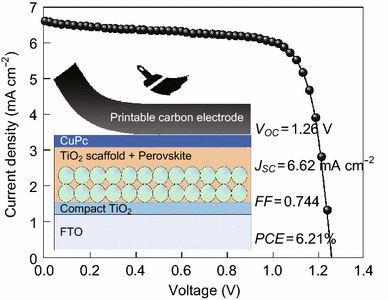当前位置:
X-MOL 学术
›
Nano-Micro Lett.
›
论文详情
Our official English website, www.x-mol.net, welcomes your
feedback! (Note: you will need to create a separate account there.)
Efficient Carbon-Based CsPbBr3 Inorganic Perovskite Solar Cells by Using Cu-Phthalocyanine as Hole Transport Material
Nano-Micro Letters ( IF 31.6 ) Pub Date : 2018-01-16 , DOI: 10.1007/s40820-018-0187-3 Zhiyong Liu , Bo Sun , Xingyue Liu , Jinghui Han , Haibo Ye , Tielin Shi , Zirong Tang , Guanglan Liao
中文翻译:

高效的碳基CsPbBr3 铜酞菁作为空穴传输材料的无机钙钛矿太阳能电池
更新日期:2018-01-16
Nano-Micro Letters ( IF 31.6 ) Pub Date : 2018-01-16 , DOI: 10.1007/s40820-018-0187-3 Zhiyong Liu , Bo Sun , Xingyue Liu , Jinghui Han , Haibo Ye , Tielin Shi , Zirong Tang , Guanglan Liao

|
Metal halide perovskite solar cells (PSCs) have attracted extensive research interest for next-generation solution-processed photovoltaic devices because of their high solar-to-electric power conversion efficiency (PCE) and low fabrication cost. Although the world’s best PSC successfully achieves a considerable PCE of over 20% within a very limited timeframe after intensive efforts, the stability, high cost, and up-scaling of PSCs still remain issues. Recently, inorganic perovskite material, CsPbBr3, is emerging as a promising photo-sensitizer with excellent durability and thermal stability, but the efficiency is still embarrassing. In this work, we intend to address these issues by exploiting CsPbBr3 as light absorber, accompanied by using Cu-phthalocyanine (CuPc) as hole transport material (HTM) and carbon as counter electrode. The optimal device acquires a decent PCE of 6.21%, over 60% higher than those of the HTM-free devices. The systematic characterization and analysis reveal a more effective charge transfer process and a suppressed charge recombination in PSCs after introducing CuPc as hole transfer layer. More importantly, our devices exhibit an outstanding durability and a promising thermal stability, making it rather meaningful in future fabrication and application of PSCs.
Open image in new window

中文翻译:

高效的碳基CsPbBr
金属卤化物钙钛矿太阳能电池(PSC)吸引了广泛的研究兴趣,因为它们具有高的太阳能到电能转换效率(PCE)和低的制造成本,因此成为了下一代溶液处理的光伏器件。经过努力,尽管世界上最好的PSC在非常有限的时间内成功地实现了20%以上的PCE,但是PSC的稳定性,高成本和扩大规模仍然是个问题。近来,无机钙钛矿材料CsPbBr 3成为具有良好的耐久性和热稳定性的有前途的光敏剂,但是效率仍然令人尴尬。在这项工作中,我们打算通过利用CsPbBr 3解决这些问题。作为光吸收剂,同时使用铜酞菁(CuPc)作为空穴传输材料(HTM)和碳作为反电极。最佳设备的PCE达到了6.21%,比不含HTM的设备高出60%以上。引入CuPc作为空穴传输层后,系统的表征和分析揭示了PSC中更有效的电荷传输过程和抑制的电荷复合。更重要的是,我们的设备具有出色的耐用性和有希望的热稳定性,这使其在PSC的未来制造和应用中具有重要意义。
在新窗口中打开图像












































 京公网安备 11010802027423号
京公网安备 11010802027423号